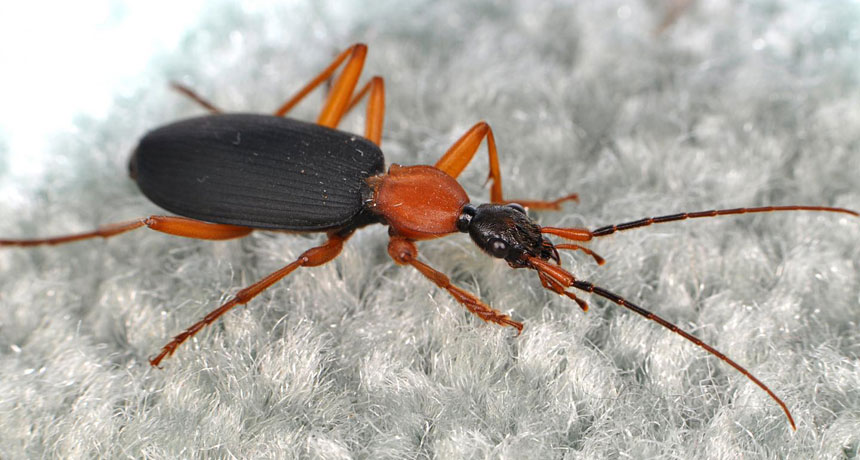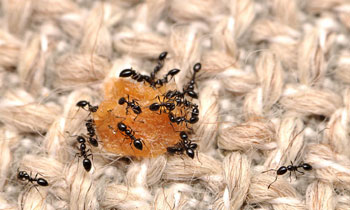Bugs that call your house home
Insects, arachnids and other arthropods are hiding in plain sight

A survey of homes found plenty of insects and other arthropods. Some, like this false bombardier beetle (Galerita sp.), probably just wander in from outside.
M. Bertone
Scientists went looking for flies, spiders, ants and other arthropods in North Carolina homes — and found plenty. In fact, no home was completely free of insects or arachnids. And only five out of 554 rooms sampled were totally clear of the creepy-crawlies. Our homes, it appears, are full of bugs. But don’t sweat it: Most were not pests.
“Despite some of these organisms living alongside us for extended periods of time, many of them are unknown to the average homeowner because [the arthropods] go about their lives in secrecy,” says Matthew Bertone. He is an entomologist, or someone who studies bugs, at North Carolina State University in Raleigh.
Bertone and his colleagues conducted the first-ever census of arthropod diversity in homes. The researchers visited 50 homes around Raleigh in 2012 and collected any living or dead arthropods in plain sight, including those hanging on spiderwebs. They also vacuumed up a small patch in the center of every master bedroom to look for dust mites. Then they brought their samples back to the lab and, to the best of their ability, identified the more than 10,000 specimens they collected.
In the January 19 PeerJ, they described what they found.
On average, each house contained 62 families — and at least 93 species — of arthropods. Some homes had 500 species or more. Bigger homes tended to have more species than smaller dwellings. But homeowners were mostly unaware of the bugs since the critters weren’t causing problems.

Pest species — the subject of most studies on arthropods found in homes — were actually pretty rare. Only 6 percent of homes had German cockroaches, 10 percent had fleas and 28 percent had termites. None of those studied had bedbugs.
Some of the bugs and other anthropods belonged to species that had evolved to live near people. But “many of the arthropods we found had come into the homes accidentally and ended up dying,” Bertone says. “For the short amount of time they exist in our homes, they are likely not affecting us in any way.” Others may be helpful, such as spiders that feed on pest species.
There could be even more species hiding in homes, though. The researchers didn’t search for bugs that may have been hiding inside drawers, behind furniture, around baseboards and ceilings or inside walls. So this study provides only a hint of the true biodiversity in our homes.
Bertone says that surveys of houses in other areas could have very different results. Some species in the North Carolina census live only in that part of the world. “However,” he adds, “many of the things we found are very common worldwide, having traveled with humans around the globe.”
Power Words
(for more about Power Words, click here)
arachnid A group of invertebrate animals that includes spiders, scorpions, mites and ticks. Many have silk or poison glands.
arthropod Any of numerous invertebrate animals of the phylum Arthropoda, including the insects, crustaceans, arachnids and myriapods, that are characterized by an exoskeleton made of a hard material called chitin and a segmented body to which jointed appendages are attached in pairs.
bedbug A parasitic insect that feeds exclusively on blood. The common bedbug, Cimex lectularius, sucks human blood and is mainly active at night. The insect’s bite can cause skin rashes and welts that look like a mosquito bite.
biodiversity (short for biological diversity) The number and variety of species found within a localized geographic region.
bug The slang term for an insect. Sometimes it’s even used to refer to a germ.
census An official count or survey of a population.
entomology The scientific study of insects. One who does this is an entomologist. A paleoentomologist studies ancient insects, mainly through their fossils.
fungus (plural: fungi) One of a group of single- or multiple-celled organisms that reproduce via spores and feed on living or decaying organic matter. Examples include mold, yeasts and mushrooms.
gall (in plants) An abnormal growth, often caused by insects, fungi or other plant pests.
insect A type of arthropod that as an adult will have six segmented legs and three body parts: a head, thorax and abdomen. There are hundreds of thousands of insects, which include bees, beetles, flies and moths.
midges Any of many types of small flies that often live around water. Some are blood-sucking insects; others can derive their energy from eating plants. Frequently mistaken for mosquitoes, midges can transmit disease or move pollutants through an ecosystem.
mite An invertebrate belonging to the broad group of animals known as arachnids, which also include spiders and ticks. None of these are insects, although like insects they belong to the larger umbrella group, called arthropods (named for their members’ segmented legs).
species A group of similar organisms capable of producing offspring that can survive and reproduce.
termite An ant-like insect that lives in colonies, building nests underground, in trees or in human structures (like houses and apartment buildings). Most feed on wood.







